Analyzing Z370 for Intel's 8th Generation Coffee Lake: A Quick Look at 50+ Motherboards
by Ian Cutress, Anton Shilov, Joe Shields & Gavin Bonshor on October 20, 2017 2:00 PM ESTASUS ROG Z370-E STRIX-E & Z370-F STRIX Gaming
Next up from the new ASUS ROG Z370 line-up is a pair of ATX sized offerings which sit within the mid-range separate group of at least four STRIX boards. Both of the Z370-E and Z370-F STRIX Gaming motherboards have a near identical feature set with a few main separating features. Firstly, the Z370-E features a set of silver metallic heat sinks, whereas the Z370-F uses a darker tough plastic. The other main distinguishable feature is the inclusion of integrated 802.11ac Wi-Fi with an antenna (that can only be described as a shark fin) found on the F.
Both of these models incorporate a single Intel I219-V Gigabit LAN controller and use the Realtek ALC1220 audio codec, a popular combination for the Z370 platform. The mid-range looks to be a congested field on Z370, but both of these boards feature identical PCB layouts including three full-length PCIe 3.0 x16 slots with the top slot running at x16 or x8 from the CPU, the second slot running at x8 from the CPU, and the bottom slot uses PCIe 3.0 x4 from the chipset. Both the top full-length PCIe x16 slots have SafeSlot reinforcement which adds additional torque protection to the slots. An additional three PCIe x1 slots are included. Overall two way SLI and 3-way Crossfire graphics configurations are supported.
Moving onto memory compatibility, the Z370-E and Z370-F Strix motherboards have four DIMM slots, supporting two DIMMs per channel, and a board rated support for DDR4-4000 MT/s. ASUS puts their higher support down to their T-Topology technology which they claim allows for stability and signal quality due to the parallel and equal length of the traces between the memory and the CPU. ASUS has stated that the 3rd generation of T-Topology is omnipresent on the ASUS Z370 range.
Storage wise, this pair of Strix ATX sized boards have six SATA 6Gbps slots and dual PCIe 3.0 x4 M.2 ports, with support for the high-end NVMe compliant SSDs. Most of the ASUS Z370 options in an ATX form factor feature six SATA ports except for the budget Z370-P and the overclocking focused Maximus X Apex. The bottom M.2 slot on these two Strix boards has an integrated heat sink which links into the chipset heatsink to aid in cooling M.2 SSDs that run hot. ASUS claims a drop of around 15c when using this heat sink.
Looking at both models aesthetically, the twin Z370 Strix boards have two contrasting designs; the Z370-E has a lighter finish with the metallic heat sinks and the Z370-F uses plastic heat sink covers with a darker charcoal finish. Both feature customisable AURA SYNC RGB lighting around the I/O cover and have room for expansion due to the dual RGB strip and single addressable RGB header; all these are also compatible with AURA SYNC.
Although not as connection rich as the high-end boards, the Z370-E and Z370-F Strix motherboards have a solid rear I/O with USB 3.1 10Gbps ports aplenty on the Z370-E. The Z370-E has a front panel connector 10Gbps USB header and dual-band 802.11ac Wi-Fi, both of which are not found on the Z370-F. Both models encompass a USB 3.1 Type-A and Type-C port in addition to two USB 3.1 10Gbps ports. Users looking to make use of on-boards graphics will be pleased with a wave of inputs including DVI-D, HDMI, and a DisplayPort; all of the three main digital connection types for hooking up to a monitor.
Finishing off the mid-range premium Z370-E and Z370F boards, we have a total of five PWM fan headers with one dedicated to AIO CPU coolers and a single header for a thermal sensor. Both of these boards fit the mid-range segment well and the Z370-E especially could be considered slightly more premium than the Z370-F. Dependant on launch pricing, the Z370-E Strix could be a serious contender, providing the performance matches the feature set and how the price sits within other manufacturer’s options.


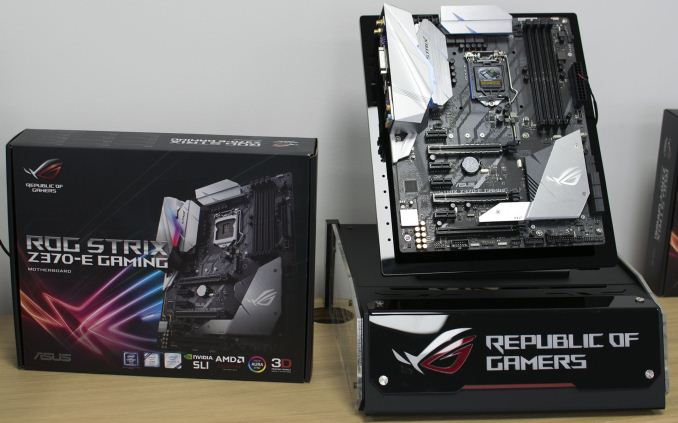
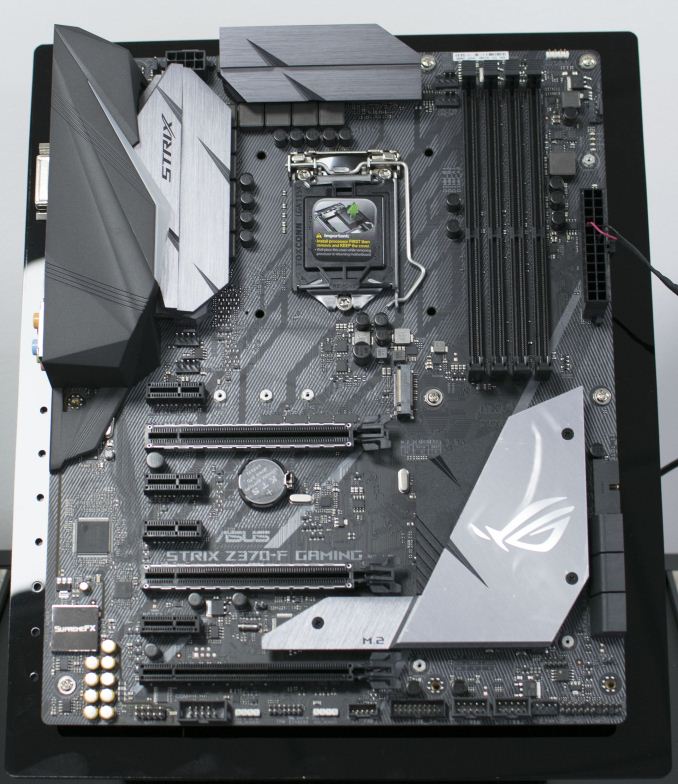
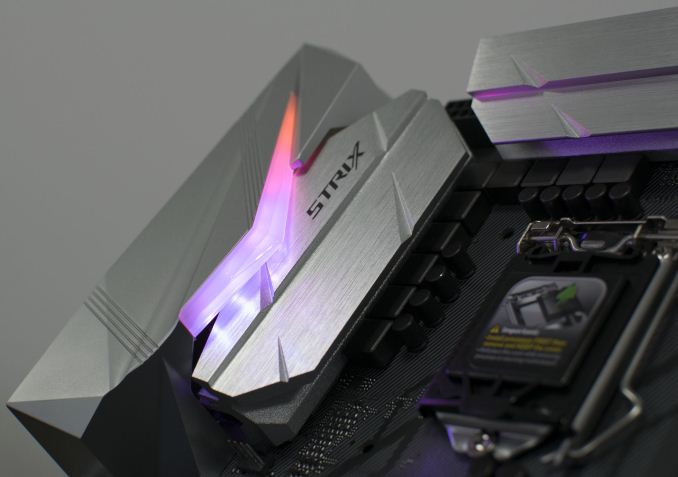
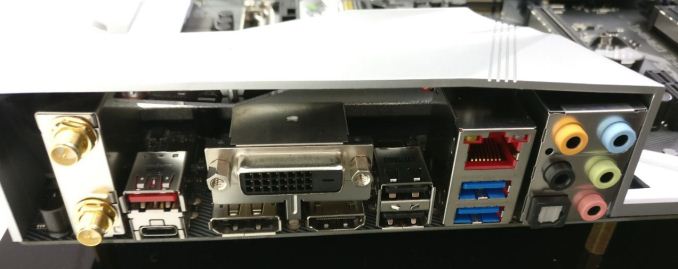
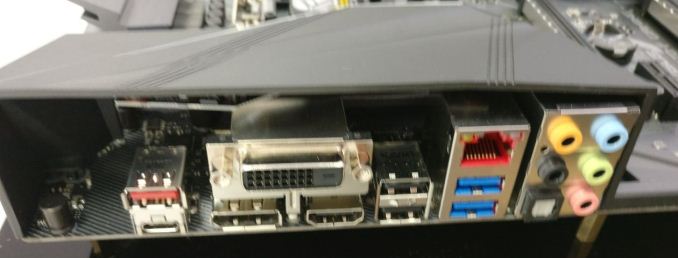








83 Comments
View All Comments
carldon - Saturday, October 21, 2017 - link
Excellent summary and table in the last page. Good work!!!imaheadcase - Saturday, October 21, 2017 - link
I got a few questions:1. Why do they put USB 2.0 ports if USB 3.0 is backward compatible anyways? Why not just all USB 3.0 ports..it can't be price.
2. Why do they have such a vary in memory timings? For %99 of people memory timings are not really a big deal right? Maybe in old PC days it was.
3. Mini-ITX vs Micro-ITX..isn't it silly both exist in first place? Any reason for this..the diminsions are really close to the same. In fact, most Micro-ITX is simply removing lots of stuff from mobo that you really want to begin with.
lordsutch - Saturday, October 21, 2017 - link
I'd imagine they want to offer as many ports as they can without taking away too many PCIe lanes. The other option would be to embed a USB 3.x switch (or a PCIe switch) but of course now each port wouldn't simultaneously be able to operate at peak speed and 3.x switches are probably more expensive than USB 2 controllers.imaheadcase - Sunday, October 22, 2017 - link
Ahh didn't think about that aspect.DanNeely - Saturday, October 21, 2017 - link
Some USB audio and 2.4ghz wifi/bluetooth devices have had interference problems in 3.0 sockets. Dunno if they're fixed on new hardware (supposedly onboard hubs were a lot worse than chipset ports in this regard so room for QC to make it better); but even if they are there's going to be problems with once burned customers not trusting them.As pointed out elsewhere USB3 competes with PCIe lanes/SATA ports on the southbridge. Especially on full ATX boards if you go to max out the number of PCIe lanes to expansion slots and m.2 ports in addition to the lanes used on board for networking and audio you can get down to only a half dozen or so 3.0 lanes left from the chipset; but still able to hit 14 USB ports total by going USB2 with the rest.
People using older OSes (Windows 7 says hi) can't use USB3 ports to install the OS without jumping through a lot of hoops (the OS sees them as not USB2 and can't talk to them).
If any board size is at risk of going away it's probably full ATX; although for enthusiast sales I suspect it'll hold on better than mini ATX due to bigger is better irrationality.
MiniITX still has a decent capability gap vs mini ATX; but it's much smaller than it was a half dozen years ago when it only made sense if you were making a tiny box and were willing to accept major performance compromises to do so. Now as Mini ITX's capability continues to goes up and the need for expansion cards other than a single GPU goes down it's eating into an increasing chunk of Mini ATX's marketshare.
On the high side mainstream chips don't really have enough PCIe lanes to make good use of the extra 3 cards of space possible on the bigger boards/ Meanwhile multi-GPU gaming - the main reason an enthusiast would need a full size mobo is steadily going away (fewer games supporting it each year, no support for 3/4way at all in the newest cards from either company); and unless you need 2 GPUs + something else or extra space around the CPU for crazy OCing Mini ATX does almost everything that could be needed.
MadAd - Sunday, October 22, 2017 - link
> If any board size is at risk of going away it's probably full ATX; although for enthusiast sales I suspect it'll hold on better than mini ATX due to bigger is better irrationality.Irrationality indeed. I would have thought by now instead of a measly 5 mATX choices out of 50+ that it would be instead maybe 5 fullsize ATX with the main battleground being the two slot mATX market.
Its just laziness on the manufacturers side, with nobody steering the market to innovate on size. Theres nobody driving form factors, the CPU companies are present on all form factors so they dont need to drive change, the board partners are all set in their ways just slapping new images on mildly reworked designs so they dont have any need to innovate, weve seen video card manufacturers can shrink designs to better fit smaller factors but we still get chunky easy to produce cards for mainstream use as retooling would be an added cost, its just rolling train of new but nothing new generation after generation.
PC design is falling into mediocrity and I just wish the main players (intel+amd/board partners/nvidia+amd) would all get together to drive SFX/ITX and force retire ATX to the strictly enthusiast market, and maybe appeal to a more contemporary home user community (rather than just gamers which is where the marketing all seems to be these days) again too.
Liltorp - Saturday, October 21, 2017 - link
It is really true that the MSI PC Pro has a legacy PCI connector? I could use this for my TV tuner. But I thought PCI was not supported by newer boatds/CPU`s?Morawka - Saturday, October 21, 2017 - link
Has anyone noticed how cheap these new Z370 motherboards are? Most are under $180 and there are several sub $130.IGTrading - Sunday, October 22, 2017 - link
Tell this to the guys that already spent money on non-Z370 just a few months ago.Intel is already screwing them.
It would have been funny to sell a 250 USD motherboard to a 7700K buyer just last month, telling him his 250 USD are a good investment because of the good upgradeability.
Just 4 weeks later tell him: "Well ... Yeah ... About that upgrade ... It will cost you a minimum of 110 USD extra + the 360 USD for the new 8700 K.
775 was the last good & long lived platform from Intel.
edzieba - Sunday, October 22, 2017 - link
If people brought Z370 boards expecting them to support an additional CPU generation, they did it in spite of every Intel CPU release for the last decade: two CPU gens socket generation. There's no counter to ignoring the past.